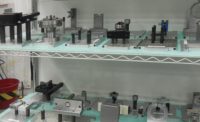My journey in dimensional inspection and quality started what seems like a lifetime ago when I ran the one-CMM quality department in my father’s aerospace engineering firm. Thirty years later, my passion for American ingenuity has never been stronger.
I was in dimensional inspection well before any general requirements for competence to produce precise and accurate testing and/or calibration data existed. Over time we have moved from the first edition of ISO/IEC Guide 25 in 1994 to ISO/IEC Guide 17025 in 2005.
ISO 17025 contains all the requirements that testing and calibration laboratories need to demonstrate they operate a sound management system, placing them in full control of their processes. Furthermore, it underscores their ability to produce technically valid test results.
There is no denying the ISO standards provide an impressive framework as to general requirements of competence. To a certain extent, ISO standards certainly appear to even imply a degree of uniformity. Organizations looking to outsource dimensional inspection may take comfort when confirming the ISO 17025 Certification exists and simply deduce all accredited labs are equal and thereby interchangeable. This assumption would be categorically incorrect. The truth is ISO accreditation is only a starting point in selecting a qualified testing provider. From there, the true work begins.
As a practical example, all automobiles are required to meet government performance requirements, but that doesn’t mean when you take a look under the hood that a Mercedes and a Fiat are one and the same. Taking a closer look at ISO labs would produce equally as diverse results. Top tier quality labs go beyond compliance, investing in expertise and capacity to satisfy industries where quality is recognized as a critical factor to their success and tight deadlines need to be met. These are typically engineering driven industries. There are also ISO labs whose business model appeals to companies whose determining factor is simply the lowest price. These are mostly purchasing driven industries where quality is looked at as more of a cost than a value.
With over 30 years of experience and thousands of questions over those years rolling around in my head as to what differentiates one ISO 17025 lab from the next, I thought it was time to compile a list. The following items might be some things for your organization to consider:
Competency– how long has the lab been in business?
Diverse Industry Experience and Background– Do the lab personnel understand how the parts in your industry are made?
Formal Education– Do the CMM specialists have four-year degrees in manufacturing engineering and/or mechanical engineering?
Expertise– Is there a senior level GD&T expert on staff for mastering blueprint interpretation?
CMM Specialists– Is each CMM operator Advanced GD&T certified to ASME Y14.5-2009?
Personnel– Is there a dedicated quality manager on staff? How many people on staff are trained and available to operate the CMMs vs. manual/hand tools?
Capacity– How many CMMs does the lab have available?
Equipment– What types and sizes of CMMs and other measuring equipment does the lab offer?
Innovation– Is the lab invested in creating new technology, increased efficiency models, and adding convenience to facilitate their clients’ growth?
Management oversight of operations/scheduling systems– What checks and balances are in place when it comes to on-time delivery and client communication?
Breadth of service– Does the lab offer custom reporting, parts pick up/delivery, custom billing, early pay discounts, loyalty programs, training (English and Spanish), program writing, calibration, personnel, equipment sales, rentals, rebuilds, retrofits?
Are all ISO 17025 accredited labs created equal? Clearly they are not. While the ISO accreditation is an impressive starting point in selecting a qualified testing provider, in reality, for industries that place a high value on the quality and reputation of their brand, it is only the beginning.
Dimensional inspection is a complex service and comes with a certain level of dependency due to the necessities of conformance. As mentioned, some companies will prefer approaches that are strictly price based while other companies like to create a more strategic partnership that can balance some of the weaknesses found in a purely market-based decision. It is well recognized, however, that both aforementioned business models have customers who are satisfied with their level of service.
So for companies who want to stay focused on their core competencies and who continue to investigate outsourcing all or part of their dimensional inspection operations, I would advise they fully review the top line goals of their organization. Once the engineering department and/or purchasing department is fully aligned with the goals and objectives of the company, then they can begin evaluating the varying standards and levels of service in the labs available to them.
Are you currently in a strategic partnership or more like one-off market based transactions when it comes to protecting your brand? It is important that today’s quality leaders understand there are substantial and marked differences between ISO 17025 accredited labs. A little research in picking the lab whose standards, protocols and breadth of services most closely align with the goals and objectives of your organization will go a long way.




